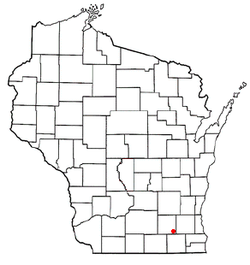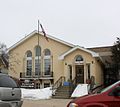Palmyra, Wisconsin
Palmyra, Wisconsin | |
|---|---|
 Looking east at downtown Palmyra | |
 Location of Palmyra, Wisconsin | |
| Country | United States |
| State | Wisconsin |
| County | Jefferson |
| Government | |
| • Type | Village Board (President - Trustees) |
| • President | David Turner |
| Area | |
• Total | 1.25 sq mi (3.24 km2) |
| • Land | 1.20 sq mi (3.11 km2) |
| • Water | 0.05 sq mi (0.13 km2) |
| Elevation | 850 ft (259 m) |
| Population | |
• Total | 1,781 |
• Estimate (2012[4]) | 1,788 |
| • Density | 1,484.2/sq mi (573.1/km2) |
| Time zone | UTC-6 (Central (CST)) |
| • Summer (DST) | UTC-5 (CDT) |
| Area code | 262 |
| FIPS code | 55-61050[5] |
| GNIS feature ID | 1583891[2] |
| Website | www |
Palmyra is a village in Jefferson County, Wisconsin, United States, along the Scuppernong River. It was named after Palmyra, Syria, an oasis city mentioned in the Bible. The name means "sandy soil."[6] The population was 1,781 at the 2010 census.[7] The village is located within the Town of Palmyra.
Geography
Palmyra is located at 42°52′37″N 88°35′13″W / 42.87694°N 88.58694°W (42.87721, -88.587117).[8]
According to the United States Census Bureau, the village has a total area of 1.25 square miles (3.24 km2), of which 1.20 square miles (3.11 km2) is land and 0.05 square miles (0.13 km2) is water.[1]
History
The Town of Palmyra was established in 1846. In 1876, Palmyra was chartered a village.[9][10]
Palmyra was known for its mineral springs. The best known was the Aurelian or Great Geyser Spring. It was 30 feet (9.1 m) across and 38 feet (12 m) deep and so clear the smallest item could be seen at its bottom. Palmyra was home to a well-known summer resort and club house called the Druggist's National Home. The home attracted visitors from across the country who were associated with the pharmacist industry.[11]
Demographics
As of 2000 the median income for a household in the village was $45,521, and the median income for a family was $50,192. Males had a median income of $37,150 versus $24,950 for females. The per capita income for the village was $19,849. About 3.4% of families and 5.4% of the population were below the poverty line, including 6.0% of those under age 18 and 4.7% of those age 65 or over.
| Census | Pop. | Note | %± |
|---|---|---|---|
| 1870 | 703 | — | |
| 1880 | 598 | −14.9% | |
| 1890 | 567 | −5.2% | |
| 1900 | 716 | 26.3% | |
| 1910 | 649 | −9.4% | |
| 1920 | 685 | 5.5% | |
| 1930 | 642 | −6.3% | |
| 1940 | 711 | 10.7% | |
| 1950 | 862 | 21.2% | |
| 1960 | 1,000 | 16.0% | |
| 1970 | 1,341 | 34.1% | |
| 1980 | 1,515 | 13.0% | |
| 1990 | 1,540 | 1.7% | |
| 2000 | 1,766 | 14.7% | |
| 2010 | 1,781 | 0.8% | |
| 2014 (est.) | 1,780 | [12] | −0.1% |
2010 census
As of the census[3] of 2010, there were 1,781 people, 704 households, and 469 families residing in the village. The population density was 1,484.2 inhabitants per square mile (573.1/km2). There were 769 housing units at an average density of 640.8 per square mile (247.4/km2). The racial makeup of the village was 94.7% White, 0.6% African American, 0.5% Native American, 0.2% Asian, 3.2% from other races, and 0.8% from two or more races. Hispanic or Latino of any race were 10.3% of the population.
There were 704 households of which 35.1% had children under the age of 18 living with them, 51.0% were married couples living together, 10.4% had a female householder with no husband present, 5.3% had a male householder with no wife present, and 33.4% were non-families. 26.3% of all households were made up of individuals and 10.9% had someone living alone who was 65 years of age or older. The average household size was 2.53 and the average family size was 3.04.
The median age in the village was 37.2 years. 25.4% of residents were under the age of 18; 8.7% were between the ages of 18 and 24; 26.9% were from 25 to 44; 26% were from 45 to 64; and 12.9% were 65 years of age or older. The gender makeup of the village was 49.9% male and 50.1% female.
Notable people
- Justin Beaver, college football player for the University of Wisconsin-Whitewater
- Adoniram J. Holmes, congressman from Iowa
- Knute Nelson, U.S. senator from Minnesota
Images
-
Looking south on Wisconsin Highway 59
-
Looking west at downtown Palmyra
-
Police station
-
Post office
-
Sign on WIS 59
-
Welcome sign
-
Powers Memorial Library in Palmyra
-
Lions Park
References
- ^ a b "US Gazetteer files 2010". United States Census Bureau. Retrieved 2012-11-18.
- ^ a b "US Board on Geographic Names". United States Geological Survey. 2007-10-25. Retrieved 2008-01-31.
- ^ a b "American FactFinder". United States Census Bureau. Retrieved 2012-11-18.
- ^ "Population Estimates". United States Census Bureau. Retrieved 2013-06-24.
- ^ "American FactFinder". United States Census Bureau. Retrieved 2008-01-31.
- ^ The Encyclopedia of Wisconsin, 1990.
- ^ "Profile of General Population and Housing Characteristics: 2010 Demographic Profile Data (DP-1): Palmyra village, Wisconsin". U.S. Census Bureau, American Factfinder. Retrieved October 5, 2012.
- ^ "US Gazetteer files: 2010, 2000, and 1990". United States Census Bureau. 2011-02-12. Retrieved 2011-04-23.
- ^ The Town of Palmyra
- ^ The Village of Palmyra
- ^ The Automobile Blue Book of 1917, vol C, Pg. 292
- ^ "Annual Estimates of the Resident Population for Incorporated Places: April 1, 2010 to July 1, 2014". Retrieved June 4, 2015.
- ^ "Census of Population and Housing". Census.gov. Retrieved June 4, 2015.
External links
- Village of Palmyra official website
- Palmyra Area Chamber of Commerce
- Sanborn fire insurance maps: 1892 1898 1904 1919









